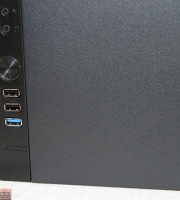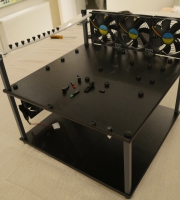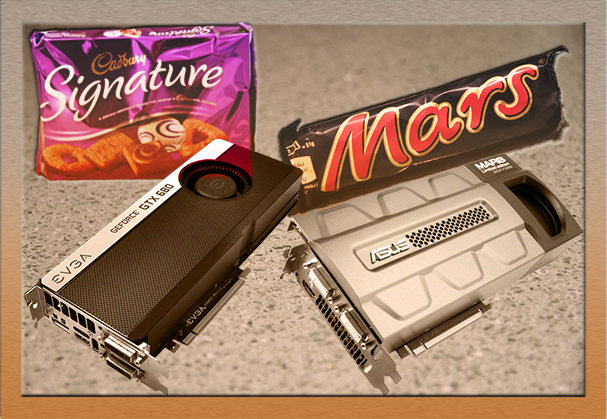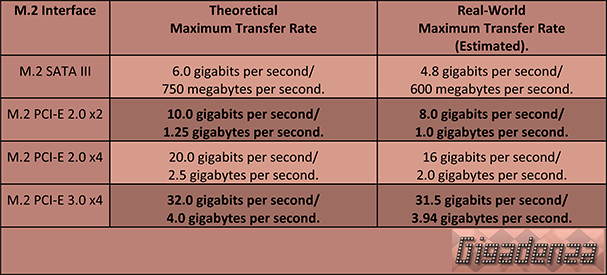


On a chill November evening in 2014, a solitary and exhausted enthusiast hitherto enamoured by most things green, black, chocolatey….

I meant PCBs. Apologies, got really confused there. Start again. A pensive PC-er previously placated by most things pix-elated and of enviable electronic eminence was ensconced at his desk.
The timeless void that was this website yielded nothing by way of assurance as he desperately delved the depths of his dwindling desires, determined to document despite a dearth of ideas. No, its no good. I shan’t do this every time, I resign.
There was once a comedian, Russell Brand was his name, who regularly sought a slew of syllables to construct his sentences and construe his sentiments where in truth, a succinct sprinkling would have sufficed and instead of Noam Chomsky’s spiritual successor, we savoured Johnny Rotten with an Oxford Children’s Thesaurus.
The enthusiast in question was myself, deflated, demotivated and dogged by a creative drought. This is me a few days later, still cocooned in the cold sigh of November 2014 but writing in the present tense. Perplexed? Good!
I’ve begun countless articles on negative notes. I’ve lamented over the way we learn of new hardware, specifically motherboards, processors and video cards along with two over ripe, worm ridden iPhones. The knowing of all before it comes to pass, NDA’s with less authority than a nanny of twenty’s declaration of bedtime on Halloween. The fatiguing confusion fuelled by excessive choice, itself brought about by caustically cynical marketing.
A few chronicles ago I cited the expanding network of telepathic tech-sites and their teams of pathologically productive journalists. Their effortless accuracy in executing and interpreting innumerable benchmarks and in delivering pages of painstaking analysis, the facts as lucid as the arguments logical.
I referred to how difficult things had become for the prodigiously knowledgeable, yet penniless hobbyist but at least strove to paint a positive picture for the most proactive. The snappy self publicists, the inspiring faces of IT independence.
How do they do it? How does one sustain the appetite to relentlessly review products whose key selling points offer barely any scope to be original? Visually they may differ in every detail but flowery rhetoric is tarnished by generic terminology:
The NEC Mutisync EA244 UHD and PA322UHD are two exciting new entries in the company’s 2014 catalogue. Each model proudly exhibits a reference quality LED IPS 4k display panel, AH-IPS for the smaller sibling and IZGO-IPS for the larger, perfectly calibrated for the most demanding professional desktop publishing and non-linear editing applications, making them indispensable to prolific videographers, photographers, and commercial printing houses.
The slighter screen sports two single link DV-I ports with a maximum supported resolution of 1920×1200 and twin 1.2 Display Ports capable of 4K 3840×2160 at 60hz. Also resident are twin HDMI ports, a built in triple port USB 3.0 hub and both monitors possess the unique ability to receive four signals via separate inputs and display each picture simultaneously at 1080p…….blah blah blah. But that’s all the in the manual and can be accessed on the site.
Summary. they’re denser, sharper, brighter, better, require less watts but burn a bigger hole in your trousers. You’ll likely never see one in the flesh, so here is some titillating imagery to aggravate your feelings of inadequacy.
Forum reaction – Pffffft! 24 inches for 4k when 28 barely enough LOL! As for the 32, give me a Dell or an Asus and £1000 to for a camera thanks, hell, I could grab a Canon 70D with a passable lens for that.
I’m sorry. I’ve just never been as good at this as all those whom I admire, and many I do not and I wish it were easier.
Remember those days when even the most bullish of board partners took months to hone their in house homages? When EVGA’s supercilious “signature editions” were as scarce as shark’s gums and Asus’s Black and Mars in shorter in supply than winning Wonka Bars…..

Not again…..quickly, somebody quash these crude allusions to confectionery namesakes and allow me to concentrate. I asked if you recalled, be it with pleasure or pain, the dawn of the of the decadent GPU rehash. Circa 2009. When parts like the Asus GTX 285 were comparable in rarity to ruby hen’s teeth or even…a Voodoo 5 6000? While the latter was famously, and tragically, never permitted to account for the tuition fees of febrile 3DFX fanatics, the launch price of the former was a mortgage worthy $1299.
This awarded the customer two fully fledged premier division GPUs, piping their pixels from inside one of a thousand credibly crafted cowling shrouds.
Come forth five years, to a frosty November sundown compounded with a deep sense of deja-vu and oh my, how trends have transformed.
No sooner have Intel and Nvidia indulged our core-most cravings with the majestic heights of Maxwell and Haswell and all vanilla flavoured variants met with voluminous and rapturous reviews, then their enhanced, enriched, fitter and fatter counterparts emerge faster than Fox News Headlines and are as common as three leaf clovers.
Sadly, there is one thing that remains a constant, their relative price. You’ll still have to forgo that scholarship, sell grannies silverware, part with your precious LPs or dare I say, flog that one month old Asus GTX 980 and donate your X99 Deluxe…who on Earth would want one of those now?
MSI X99s Gaming 9 AC
This imperious Hawell-E initiator was one of MSI’s finest feats
It’s partner in priming, the X99s XPower AC, was touted as the over-clockers saviour, and boasted a stronger PCB, voltage checkpoints and extra durable capacitors though to the eye, save for yellow trim and a lack of EMI shielding, it was identical.
As the name implies, the Gaming AC was intensely targeted at steamers and streamers. Its defining traits were an integrated Avermedia H.264 hardware encoder, compatible with XSPlit’s broadcasting software and, like the Live Gamer HD, capable of monitoring footage at 60 fps and capturing at 30 fps, with a resolution of 1080p in each case.
To exploding communities of gamers and let’s players seeking a superior means of sharing their toils and triumphs, this trimming was exceptionally appealing. Software based recorders such as FRAPS, DXSTORY and Bandicam had long dominated frame grabbing culture and despite they’re modest prices, all racked up hidden costs by relying on meaty CPUs and several dedicated hard drives to achieve acceptable results.
In contrast, hardware equivalents – read about some here – consumed valuable space and necessitating the graphics card’s signal to be previewed and captured externally. HDMI or DVI splitters were also recommended if one sought to avoid refresh rate anomalies.
MSI’s integral solution was the first to combine spacial practicality with quality and efficiency. Or was it? What of Nvidia’s Shadowplay? How about AMD’s GVR? Both of these were driver supplements and tapped the talents of the GPU, whose native encoding facilities were a virtual formality and provided definition inferior to none. Too little too late MSI?
The board’s built-in audio facilities were finely engineered, with gold plated connectors and a hefty guard concealing the chipset to prevent interference from nearby components. Did they steal this concept from Asus?
Sigh, its happening again, wretched language. I feel like Blackadder rewriting Dr Johnson’s dictionary, him stranded on Aardvark, myself on motherboard one. Let us proceed with simplicity.
The usual stocking fillers. OC Genie, click BIOS, OC essentials and Guard Pro all expounded upon in devastating detail by the MSI themselves hence I shan’t rephrase abridge or promote.
USB Audio power. Optimally regulated the 5v signal transmitted to the board’s USB ports, guaranteeing external sound cards and DACs could attain the cleanest possible output. Hmm, I’d have thought the PSU played a bigger role here.
ASUS X99-E WS/ASUS Rampage V Extreme /MSI X99s Gaming AC/Gigabyte GA-X99 SOC Force.
All four of the above flaunted a single “Turbo” M.2 connector, known commonly as M.2 PCI-E Gen3 x4. This interface drew four third generation PCI-E lanes from the CPU’s generous consignment, providing a theoretical maximum transfer rate of 32 gbps, twice that of the protocol’s previous implementation, M2 PCI-E Gen 2 x4, but thankfully compatible with older M.2 PCI-E Gen 2 x2 SSDs such as Plextor’s M6e.
Goodness, if there was one piece of technology I felt couldn’t possibly present the customer with a more perplexing picture, it was this otherwise intriguing and agreeable form of data retention. So begins…
A Winter of Disk-content.
Every allusion and statistic adorning these pages serves to remind me as much as inform readers and when darting back and forth between the websites of these voracious vendors, it’s easy to see why. Grounds for costly confusion are revealed by the click.
Their insatiable compulsion to expound on progressively exhaustive lists of exclusivities, is the frequent cause of careless oversights or conveniently misleading specifications, while other vital information is lost in translation. To illustrate, here is one incorrigibly irritating case of conflicting claims.
The M.2 socket soldered to Gigabyte’s garish ensemble was an enigma, examine the following nugget of promotional naffness, duly nipped from the motherboard’s microsite…
“Turbo M.2 Technology Fast Onboard Storage”
GIGABYTE X99 SOC motherboards feature a Turbo M.2 socket to provide compact connectivity for SSD devices. Thanks to the unique design from the X99 chipset, 4 PCIe (Gen.2) lanes can be allocated to the M.2 socket, unlocking up to 20 Gb/s of bandwidth. Turbo M.2 offers considerably faster storage performance than current mSATA and even SATA Revision 3 (6Gb/s) storage devices.”
OK, got that? And here is what MSI had to say about the same feature
“Push your SSD even harder with Turbo M.2”
Push your SSD even harder with Turbo M.2 Delivering speeds up to 32Gb/s using Gen3 x4. Turbo M.2 is the successor to M.2 10 Gb/s, offering 3 times greater performance up to 32 Gb/s using Gen3 x4. M.2 is packed in a small form factor and is compatible with 3 different sizes to fit most storage solutions. All latest generation Intel based MSI motherboards feature Turbo M.2 storage.”
So which is correct? is it 20 or 32Gb/s? Is it four GEN2 or GEN3 Lanes? Is it gigabits per second or gigabytes? I speak in earnest when declaring that half an hour of Googling was essential to unearth the answers.
First, to help refine what suited statisticians rejoiced in obfuscating, I must nestle some cute table candy right here,

Oh! The relief! Open your eyes, gratify yourself with that glorious clarity. Delight in data that could be used to recoup decades of errors and prevent centuries of forum warfare. There are moments when I feel my entire life could be recounted through tables. So what was Gigabyte’s game? Why did they imply the X99 can only call on Gen2 PCI-E lanes for M.2 mobility and not as MSI informs, GEN3. As it turns out, both impart the truth, though one version is slightly crafty.
Gigabyte chose to exploit a concept first paraded on Intel’s z-87, which furnishes manufacturers with eight bonus Gen2 lanes from the PCH, to deploy to slots, sockets and ports at their discretion. It was christened “FLEX i/o”, and despite no official acknowledgement, remained an active element in the x99s design.
Meanwhile, MSI elected to assign four GEN3 lanes directly from the CPU, the preferred method of implementing M.2 on the x99, and thus, the stated maximum speeds differed. Ah! Praise IT, a world where facts are as solid as sand and figures as clear as clay. Let’s move on.
Asus X99-WS/Asus Rampage V Extreme.
Both of Asus’s maternal marvels accommodated a pair of Sata Express connectors, one wired to the main chipset, the second to an Asmedia controller. Owing to reverse compatibility, this formed swathe of 12 SATA III 6GB ports.
Every other Asus x99 based board (all 99999999999999 of them) also incorporated a propriety “OC”2011-3 socket, ingeniously engineered via six additional pins to circumnavigate the Haswell’s built in voltage regulator and provide a healthy wattage bonus to the CPU and memory. The result? Yet more record ravaging over-clocking.
Gigabyte GA-X99 SOC Force.
A questionable colour scheme, but admirably crafted bandwidth . All 40 lanes from the CPU could be utilized to cater for three and four way GPU setups, amending their traditional bandwidth quotas of 8/8/16 and 8/8/8/8 to 8/16/16 and x8/x16/x8/x8 respectively. Thus we discover why Gigabyte chose to initialize their M.2 port via the PCH instead of the processor. Those four spare lanes were essential to activate this feature.
EVGA X99 Classified
Winter 2013 brought EVGA mixed reception for its heavily hyped x79 “DARK”, which could in hindsight be described as a cynical attempt to distract new customers from the bitterness encompassing adopters of its three forerunners, none of which at the time had received an Ivy-Bridge BIOS and were beset with hindrances the company in fairness, eventually addressed.
The belated flagship drifted onto the shelves several months in advance of Asus’s similarly styled but infinitely more polished and acclaimed Rampage IV “Black”.
Speaking as the owner of what is traditionally cited as the most bug ridden and sloppily marketed product ever to evolve from EVGA’s expertise – my flawed genius, the SR-X – I should be compelled to agree with the above theory and condemn them for far worse, though I’ve never believed such shameless opportunism to be a driving force in their philosophy. Where both Asus has deserted me, they have stood fast, despite a deficit of over 20,000 employees.
Their forums may grant you the silent treatment if the issue in question is already under review but negative posts, even the most scathing, are never removed or artfully edited. Nevertheless, the Dark was and remains a difficult case to defend and one best summed up as a desperate appeal to those with deeper pockets than the Sultan of Brunnei and more benevolence than the Dalai Lama’s sandals (the ones he donated in 2010) to liberally gamble on a product whose fixes and features should have been present originally. Having worked hard to steady its course following the departure of several key engineers, not least Peter “Shimano” Tan, it was imperative that this zealous manufacturer’s maiden Haswell-E portfolio demonstrated a reversion to the rock solid reliability and eminent customer service that had initially assured their survival in an ocean of corporate carnivores.
So, let us inspect. Ten phase power distribution. Theoretically the thinnest granularity of all x99 boards, including those undisclosed here. No SATA Express but a stereophonic quintet of SATA III supremacy (that’s 10 ports), two M.2 Sockets and a typically flashy UEFI BIOS bulging with the usual variety of variables.
MSI X99s Gaming AC/Gigabyte GA-X99 SOC Force.
In the case of Gigabyte’s piercingly peachy PCB – an allusion to colour and not necessarily build quality – we have a lone SATA Express socket, initialized by two Gen 2 PCI-E lanes from the PCH and hence, bandwidth of 10 GBPS over which to bounce bytes. As both its M.2 and Sata Express interfaces were primed by the PCH, only one at a time could serve its starving SSD.
MSI’s next generation storage synergy was intriguing. As explained, the board’s M.2 socket was allotted a four lifelines from PCI-E’s tertiary order directly from the CPU while the Sata Express port secured its sustenance from the PCH in a pair of second generation lanes.
This atypical delegation of reserves endowed the board with a rare, perhaps unique attribute to power M.2 and Sata Express devices simultaneously provided the M.2 socket was operating in Gen 3 mode, which it only did when the fourth PCI-E x16 slot was vacant, when it wasn’t, the board would deftly divert the M.2 port from the CPU’s lane supply to that of the PCH, thereby switching to GEN 2 transfer rates, halving its lane count and relegating both it and the Sata Express socket to a state of mutual exclusivity.
According to MSI’s manual, if a 40 lane CPU was installed (the 5930k or 5960x) and the user wanted to setup three way SLI, it was statutory to use this enigmatic fourth slot to evoke a PCI payload of x16/x16/x0/x8, maxing out the processors lane quota and making it impossible to preserve optimal M.2 bandwidth. On the other hand, if the 28 lane empowered 5820k were the mother ship’s master and commander, the third x16 slot came into play, all three populated slots ran at x8 for a total of 24 lanes and the M.2 slot retained its twice two GEN 3.
According to any with an iota of common sense, those who had a 40 lane CPU and didn’t mind forgoing a fraction of graphical gratification could simply replicate the latter layout and experience an almost unrestricted x8/x16/x8 configuration.
Sata Express – A Side Note.
2014 was a transitional period of terabyte tyranny and there were no drives with which to showcase the spoils of Sata Express, at least not for us. Asus had been vociferously approving the protocol from its inception and Results derived from their “Hyper Drive”, demonstrated in April the same year, saw it overhaul the velocity of vanilla SATA III by almost a third, though how it would fair long term against its cable free rival and what impact searingly pacy slot based SSDs were to have on both, or weather the two could peacefully co-exists were tales told in another era. Fortunately, the connector doubled up to the avail of two standard SATA drives.
EVGA X99 Classified/MSI X99s Gaming AC
Support for 4 way SLI with every Haswell-E processor, including the popular baby bear. There were rumours that the 5820K with its frugal 28 lanes could only organize a 3 way pixel party, but the bountiful bandwidth (32GB/s) accompanying PCI-E’s 3rd incarnation married to a logical designation of resources proved more than adequate.
Of course, 4 way SLI was next to useless due to poorly developed drivers and latency issues but an additional PCI-E 3.0 x4 slot for those who had chosen not to enlist mummy or daddy bear still offered numerous excuses to sensibly squander the remaining budget. Hospitality for a Mushkin Scorpion? Or an advanced video production card from the likes of Black Magic. What else? Use your imagination, I’m a weary man.
Asus X99-WS
Outstanding scope for expansion. Seven senior slots and a double dusting of multiplexing magic (two PLX PEX8747s) meant this monster could appear to muster 64 PCI-E 3.0 lanes irrespective of the processor installed and that every slot could be populated without compromise.
“If PCI-E x4 Slot1 is occupied, then USB 3 headers 1 and 2 will be disabled. If PCI-E x4 slot 1 is occupied by custard or treacle, then a Door mouse will delete your steam account ….and so on. No such worries with an Asus Workstation.
The first and last to grace my cases at length, and only in light of my subsequent longing for dual delectation, was The P6T7 “Supercomputer” in 2009. For three years this gallant x58 galleon, a worthy Westmere manning its mast, nobly negotiated savage seas of primes, pixels, frames and wavs.
There were no fancy PLX Chips back then, only old Green Eyes’ infernal elder, the NF200, of which he housed two, but their mission to optimize the management of PCI-E bandwidth was identical to that of their cooler, more efficient descendants.
EVGA’s maiden Classified, another x58 laden flagship was unveiled the same year, and also harboured one of these meaty multiplexors. I had the good fortune to own both.
The Classified was a limited edition enclosed with a a certificate of authenticity, intended to ignite in the the customer an intoxicating feeling of pride and regality similar to that invoked by Luis Vuittons luggage.
Despite this valuable accoutrement, the board’s eSATA port ceased to be within a year and when EVGA’s traditionally impeccable support team failed to find fault, it was to overwhelming fickleness that I gave way.
The conservative heat sink on the P6T7 was hauntingly reminiscent of that observed here and decidedly apt in placating the verdant flames beneath. I don’t recall a single crash that wasn’t accounted for by slack software, defective drivers or a virulent virus. Two and 3 three way SLI were as smooth as Egyptian cotton, exhibiting none of the latency penalties habitually attributed to the NF200 bridge.
Not a single stick of memory ever needed replacing and all ports and slots functioned flawlessly for the duration of its reign. Why do I so forcibly recount stories of tenuous relevance?
Bullet points and present tense alert…